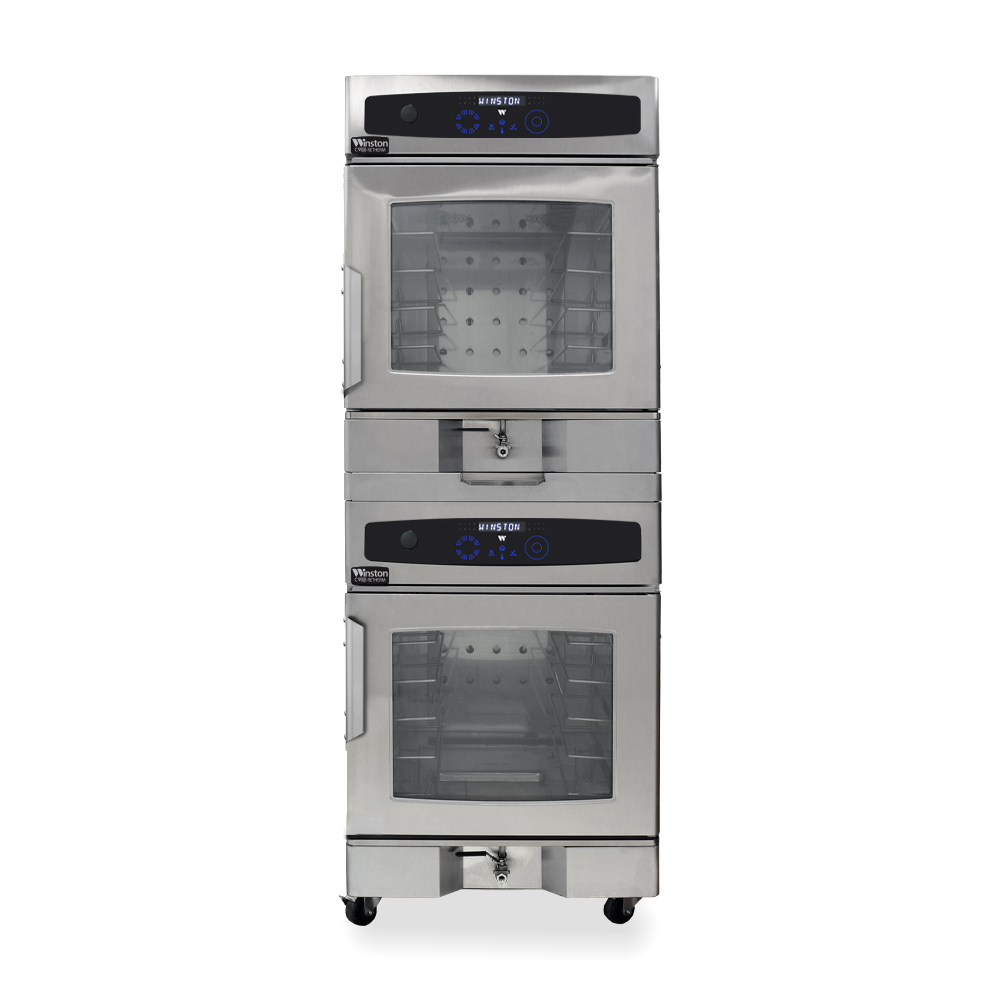Rethermalizer Ovens
Series 7 | Series 5 | LEGACY | COOK AND HOLD
The CVap® Rethermalizer Oven is a fast-cooking oven that can cook with amazing precision. These ovens can bake, poach, braise, roast, low-temp steam, and even sous vide. They’re a great alternative to combi ovens, but much more affordable.
Series 7
Series 7 Retherm Ovens are Winston’s top-of-the-line ovens. Built with brains and brawn, they will be the rock stars in any commercial kitchen.
- Capacitive Touch Controls
- 8 Adjustable Preset Channels
- Audio Port, HACCP Data Download
- Switchable Convection Fan
- CVap Wireless Programming (via NFC device or USB)
For even greater precision, add an optional food probe. These powerful ovens are a great solution for your kitchen needs.
Series 5
Series 5 Retherm Ovens deliver serious performance. Series 5 ovens bring fantastic features.
- Capacitive Touch Controls
- 8 Adjustable Preset Channels
- Audio Port, HACCP Data Download
- Convection Fan
- CVap Wireless Programming (via USB)
These commercial ovens are great solutions for foodservice operations that need to serve lots of food very fast. They produce quality and quantity.
What is Retherming?
First, let’s explore what it means. Then, we will discuss the oven and its features. Retherming is reheating previously cooked food to a safe temperature. According to the USDA, prepared food must be reheated to an internal temperature of 165°F within two hours, or it must be discarded. Cooking times of 90 minutes are preferred to allow a safe amount of flexible preparation and cooking time.
One of the key benefits of rethermalizer ovens is that they enable food to be cooked or prepared off-site and then safely reheated at the point of service. This makes them especially valuable for centralized production kitchens that distribute food to satellite locations such as schools, hospitals, or catering venues. Most of Winston’s ovens are designed to reach a maximum temperature of 350°F, which is sufficient to safely reheat food without overcooking it. Because they operate below the threshold that typically triggers commercial ventilation requirements, these ovens often do not require a traditional ventilation hood. However, this may vary based on local codes and regulations.
Efficiency
Granted, in many respects, these ovens are similar to low-temperature convection ovens or cook and hold ovens.
However, retherm ovens have greater wattage and air movement. Consequently, this improves energy transfer efficiency. The efficiency is the transfer of energy from a heated cabinet to a thermal mass (food) at a fast and controlled rate. In other words, retherm energy efficiency is a measure of how much of the energy that an oven consumes is delivered to the food product during the rethermalization process.
Critically, the larger the thermal mass, the more energy (kW), is needed to transfer to the mass. In the same regard, the more energy (kW), the faster the thermal mass can absorb the energy and reach desired temperatures. Consequently, this makes retherm ovens ideal for reheating chilled or frozen foods. They deliver lots of energy, quickly.
Heating Quickly and Safely
Most standard thermalizers use robust air circulation to reheat food.
Volume feeding presents unique challenges. Above all, how does one provide fast results, without overcooking or dehydrating food? One option is a combi oven. These powerful ovens can operate as convection, conventional, or steam ovens. While they are extremely fast, they’re also extremely expensive. However, combi ovens require a big initial investment, and continuous maintenance and chemicals to keep in good condition. Importantly, one should definitely consider TCO when contemplating the best oven for their operation.
During the reheating process, food is quickly brought back up to a safe serving temperature. Once the set temperature has been reached, the oven automatically switches to hold mode, keeping products hot and ready until serving time.
If multiple loads are required, many manufacturers offer holding cabinets. These specialized cabinets keep cooked food at a hot, safe temperature until serving. Importantly, these can free up the retherm oven for additional batches.
Presets and Channels
Many of Winston’s ovens offer preset menu selections. Each menu channel has a different set of oven parameters, and each channel is ideal for a specific group of menu items

Factors affecting oven temperature and cook time when retherming:
- State of Food: Slacked vs. frozen. Slacked food has been defrosted to 41°F. Naturally, slacking is recommended when retherming, as it cuts down the cooking time. Of course, most retherm ovens are capable of cooking prepared frozen foods within the food-safe time window. They just take longer.
- Product Density: Denser food products lead to longer cook times.
- Oven load: Greater space between products promotes better air movement, resulting in shorter cook times. In other words, don’t overload your retherm oven.
Ideally, retherm ovens:
- Retain nutritional value.
- Maintain food flavor and texture.
- Simplify meal transportation.
- Reduce meal and labor costs.
- Achieveconsistent food quality and food safety.
- Save space.
Retherming reduces food shrinkage and increases food quality. Because they don’t generally require vent hoods, retherm ovens allow you to prepare food in locations you wouldn’t otherwise be able to (local codes prevail). Indeed, this can open additional cooking capacity within limited footprints.










